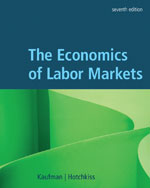
ECN 3890 - LABOR ECONOMICS

Objectives:
At the end of the semester, students should understand:

Required Textbook:
Kaufman, Bruce E. and Julie L. Hotchkiss. The Economics of Labor Markets, 7th edition. Thomson/South-Western Publishing, 2006.
Grading:
Grades will be determined using a 10-point scale. There will be no "curve". Final grades will be comprised of:
Please note:
If you have a documented disability and wish to receive academic accomodations, please contact me and the Coordinator of Disability Services (581-6583) as soon as possible.
Policies:
Homework
We will have several homework assignments throughout the semester. These will be given at the end of class
and will be due by the beginning of the next class period. Since we will have many assignments,
I will drop your lowest homework grade in determining your final homework average. Therefore, NO late
homework assignments will be accepted (regardless of whether the absence is excused or not). If you miss class when
an assignment is given, it is your responsibility to get a copy of the assignment and complete it
by the due date. No late homework assignments will be accepted at any time - no excuses!
Answers to Homework:
Homework4 REVISED!
Attendance
Regular attendance is necessary for you to understand the material covered in this course. While I will
not make attendance an explicit part of your grade, keep in mind that it may be used in determining the final
grade for a student whose average is near a borderline.
Exams
All exams will consist of short-answer essay questions and problems. The final exam is NOT cumulative.
However, the last unit exam will be given during the final exam time. If you miss an
exam and provide me with a legitimate (and properly documented) excuse BEFORE the exam,
you will have the option of increasing the weight of your remaining exams or taking a make-up exam (which must be taken before or during the next
class period following the exam).
If you miss an exam and do not provide me with a legitimate excuse beforehand, you will receive
a grade of zero for that exam.
Review Questions for Exams:
Course Outline:
I. Introduction
Key points:
II. Introduction to the Labor Market
Key points:
Reading:
Chapter 1
III. Labor Supply
Key points:
Reading:
Chapters 2, 3
IV. The Theory of Human Capital - Part I
Key points:
Reading:
Chapter 7 (pp. 326-353; 373-379)
Exam 1 - Thursday, February 22th (REVISED!!)
V. The Demand for Labor
Key points:
Reading:
Chapters 4, 5
VI. The Determination of Wages
Key points:
Reading:
Chapter 6
Exam 2 - Tuesday, April 3rd (REVISED!!)
VII. The Theory of Human Capital - Part II
Key points:
Reading:
Chapter 7 (pp. 354-369)
VIII. Occupational Wage Differentials
Key points:
Reading:
Chapter 8
IX. Discrimination in the Labor Market
Key points:
Reading:
Chapter 9
Exam 3 - Tuesday, May 1st, 2:45-4:45